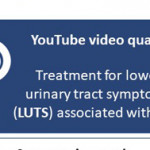Editorial: Fake news about benign prostatic hyperplasia on YouTube
YouTube is a widely used video‐sharing and social networking platform. It contains a large volume of content about medical topics, including urological conditions. In this issue of BJUI, Betschart et al. [1] examined the quality of 159 YouTube videos about surgical treatment of BPH with ≥500 views. The median overall quality of videos was poor (2 out of 5 possible points) based on validated criteria for the assessment of consumer health information. Nearly 87% of videos contained some misinformation and 84% had commercial bias.
We previously reported similar findings in the first 150 videos in a YouTube search for prostate cancer [2]. The median overall quality of videos was moderate (3 out of 5 points), and 77% contained biased and/or misinformative content in the video or comments beneath it. Furthermore, videos with lower expert‐rated quality had higher user engagement.
In the study by Betschart et al. [1], most of the YouTube videos about BPH had very good production quality, and 69% were posted by healthcare providers (e.g., doctor, clinic, hospital or university). These attributes might lead health consumers to have more trust in the information that is provided. In fact, they found that two‐thirds of videos with the most views in each topic had a quality score below the median score for videos about that topic.
Unfortunately, these issues are pervasive across many health domains. A recent review article reported on the prevalence of commercial bias and misinformation in social media posts about a variety of urology topics, including female pelvic medicine, endourology, sexual medicine, and infertility [3].
What can be done to combat the large quantity of misinformative urological information circulating online? For BPH on YouTube alone, Betschart et al. [1] reported that there were >12 000 videos as of May 2019. It is not practical for medical experts to manually vet the vast and continually changing repository of online medical information.
One future possibility is the development of computational tools to help evaluate the quality of information. For example, using an annotated dataset of 250 YouTube videos about prostate cancer, we created an automatic classification model for the identification of misinformation with an accuracy of 74% [4]. Further study is warranted to develop and test the use of machine learning to help filter the quality of online content.
As healthcare providers, what can we do to address these problems in the near‐term? We previously reported that USA adults who perceive worse patient‐physician communications are significantly more likely to watch health videos on YouTube [5]. This highlights the importance of shared decision‐making and proactively directing our patients to trusted sources of information. A curated list of reputable sources of online urological health information is presented in a recent review [6]. In addition, healthcare providers should be encouraged to actively participate in social media to flag any content that is inaccurate or dangerous and to help provide accurate information to the public. The BJUI, European Association of Urology, and AUA have all published guidance regarding best practices for social media engagement, which should be incorporated into urological education in the future [7].
In conclusion, social networks have a huge global audience and offer great potential to benefit the care of BPH and other urological conditions. However, to meet this potential and offset the risks will require significant ongoing efforts from the urological community.
by Stacy Loeb
References
- Betschart P, Pratsinis M, Müllhaupt G et al. Information on surgical treatment of benign prostatic hyperplasia on YouTube is highly biased and misleading. BJU Int 2020; 125: 595-601
- Loeb S, Sengupta S, Butaney M et al. Dissemination of misinformative and biased information about prostate cancer on YouTube. Eur Urol 2019; 75: 564– 7
- Loeb S, Taylor J, Borin JF et al. Fake News: Spread of misinformation about urological conditions on social media. Eur Urol Focus 2019 [Epub ahead of print].
- Hou R, Perez‐Rosas V, Loeb S, Mihalcea R. Towards Automatic Detection of Misinformation in Online Medical Videos. International Conference on Multimodal Interaction. Suzhou, Jiangsu, China: ACM, 2019. Available at: https://arxiv.org/abs/1909.01543. Accessed January 2020
- Langford A, Loeb S. Perceived patient‐provider communication quality and sociodemographic factors associated with watching health‐related videos on YouTube: a cross‐sectional analysis. J Med Internet Res 2019; 21: e13512.
- Langford AT, Roberts T, Gupta J, Orellana KT, Loeb S. Impact of the internet on patient‐physician communication. Eur Urol Focus 2019: 31582312 [Epub ahead of print].
- Taylor J, Loeb S. Guideline of guidelines: social media in urology. BJU Int 2020; 125: 379-382



